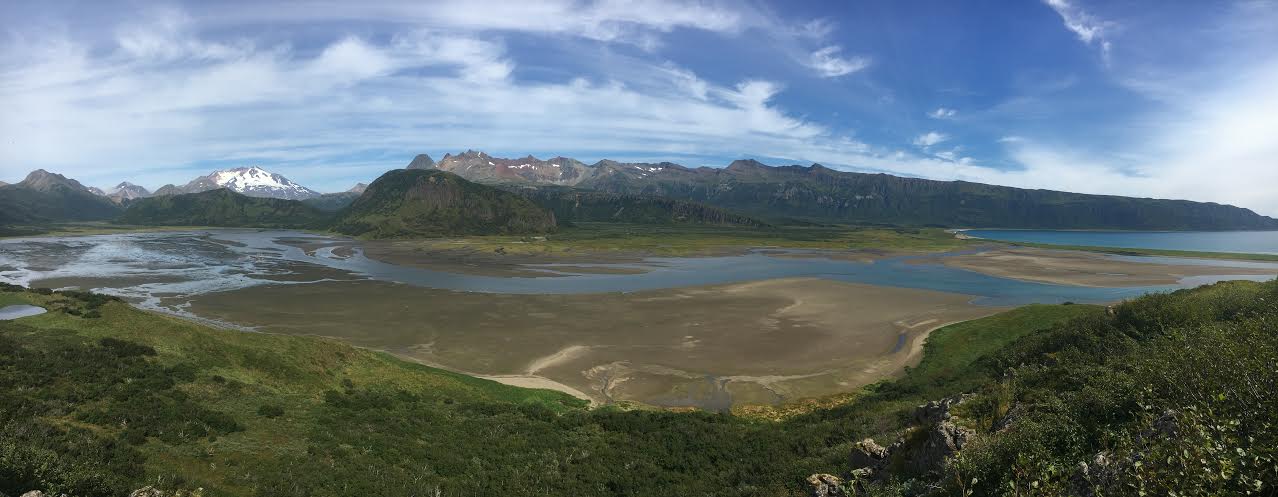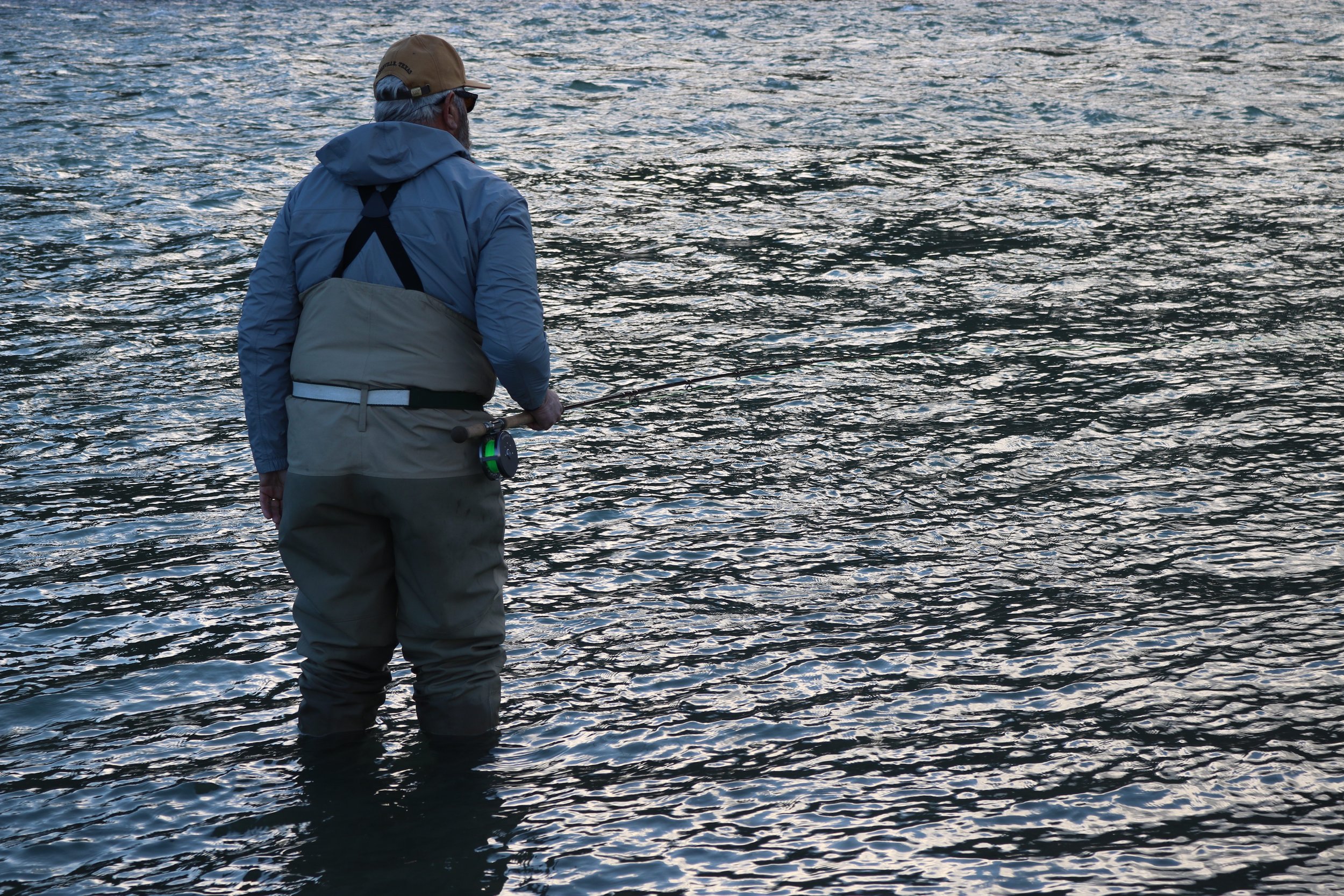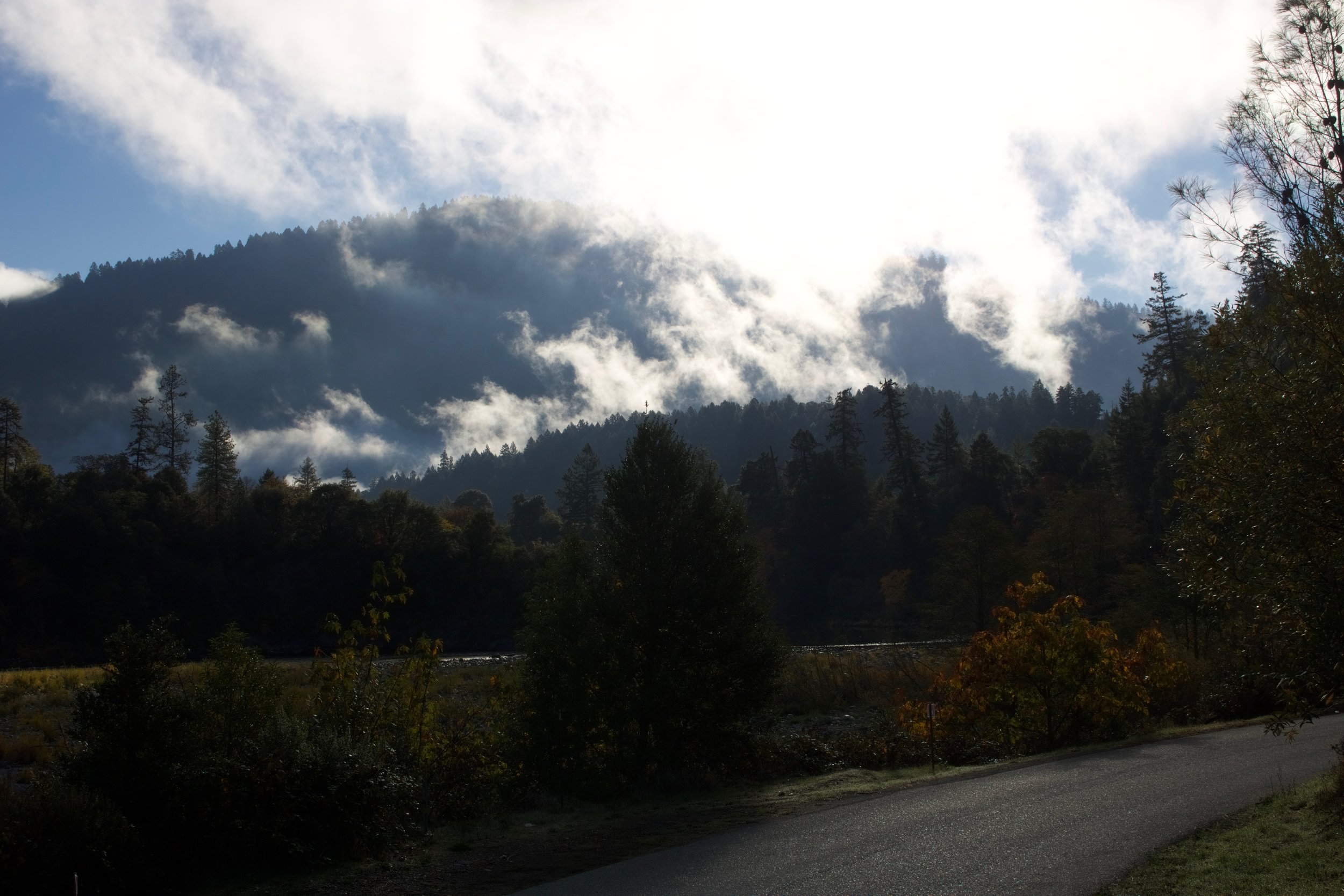The Bear Cult
Something stirs in the darkness, breaking the stillness of a moonless night. Outside the walls of our tent, somewhere out beyond the clear vinyl flap that zips down at the entryway, an animal has entered the perimeter of our camp. The Vietnam era military grade receiver that lives below our wooden cot squawks with ever increasing alarm. Ground sensors that are scattered throughout the front of our remote wilderness fly fishing camp relay the cacophony of tremors back into the tent, as whatever treads out in the pitched blackness ambles along.
Image by Wesley Griffith
Now we sit up in silence, my boss and I. It has become a familiar routine in which few words need be exchanged. In place of torches we grab our headlamps. In place of spears we reach for our shotguns. The signal intensifies. The animal is close now. Tired eyed and half dressed we venture out from the safety of the tent into the cold night air of the desolate Alaska Peninsula. The stars are out tonight, littered across the cavernous void of sky above.
We move through the front of our camp mostly in silence, listening for some sign of our uninvited guest. Neither of us needs to do much guessing as to who has woken us and drawn us out into the night. The heavy reports eminating from the antiquated box within our tent has already told us enough. Old light-foot has come again, the standard of the north, the bear.
Of ancient origin
Imagine a time before the story of the world was written. Before iron ships and forged steel. Before ink put to parchment. Before slabs of marbled stone adorned the hillsides. Before the temple built by hand, when there was only the mountain and the woods. Only the sea and the land. When shelter was a cave, and the world was as endless and unknowable in it’s entirety as the cosmos is today.
Animated by Wesley Griffith
It begins around the dying embers of a fire, as a story told countless times and in many ways is told once more. A story about how the world was given its shape and how the bear came to be an emblem of the north.
The Greeks
On the sun baked shores of Crete is the Arkoudiotissa Cave. Here for untold centuries the faithful have come to pay homage. Now a ruin, this place once housed the worshipers of Artemis; the Greek goddess of the wilderness, its animals, and the hunt. From her we find the story of Callisto and her son, Arcas.
In the glen
Callisto was a nymph and the daughter of Lyceon, King of Arcadia. Being a devoted follower of Artemis she swore a vow of chastity to the Goddess. As he was so often known to do, Zeus, having transformed himself to resemble Artemis, seduced Callisto and impregnated her. Soon she could no longer hide her pregnancy, enraging Artemis for having broken her vow, and was cast out into the wilderness. She gave birth to her son, Arcas, but having done so raised the ire of Zeus’ wife, Hera, who took her revenge by turning Callisto into a bear.
Animated by Wesley Griffith
Arcas, being the son of Zeus, was hidden from the wrathful Hera. He was raised by his maternal grandfather, King Lyceon, and eventually would go on to become the King of Arcadia. He was a master hunter, and it was on one fateful hunt that he came across a great bear deep in the woods. He drew his spear, unaware that he was on the verge of killing his own mother. Just before he was able to deliver the mortal blow the gods intervened. Zeus took mercy on them both, lifting them from the earth and placing them in the heavens. Today they can still be found there as the constellations Ursa Major and Ursa Minor.
Etymology
And so the ancient Greeks offer this tale of how the fabled constellation so familiar to all who live in the Northern Hemisphere came to be. Yet even in ancient Greece this story of a bear being depicted in the night sky was an old one. What is significant is the root word derived from the son of Callisto, Arcas.
Arcas is represented in the sky by Ursa Minor, the lesser bear or little bear. Found within this constellation is the north star, Polaris. This marriage between the tale of the bear with the celestial symbol of the north endures to this day. It is why we call the northern region of our planet the Arctic. This word, Arctic, stems from the ancient Greek for bear, Arctos. Now we can see how from the name of our Greek hero, Arcas, we arrive at a word representing both Bear and North as one unified idea.
Image by Wesley Griffith
Of course the Ancient Greeks and their Roman counterparts lived in the south, where encounters with the bear would be somewhat less common place. Perhaps this is why they freely referred to the animal by its given name; Arctos for the Greeks, Ursus or Ursa for the Romans. Yet for the northern people, those who would have lived in closer proximity to the bear, to call it by it’s name became a taboo. If this was born out of reverence or fear is not always clear, but it’s what gives us many of the names for bear that we find scattered throughout much of Eurasia today.
The word bear is of Germanic origin, and replaces their original word, Arkto. Some say that the replacement word meant “brown one”, while others link it to the Proto-Indo-European word Gwer, meaning “wild animal.” At any rate it became an early example of euphemistically referring to the animal. A similar occurrence can be found in the Russian world for bear, Medved, which means honey-eater. The med being related to the word mead. The Baltic tribes found another circumlocutory term to avoid addressing the bear by its given name. Their host of names include the Lithuanian word for bear, Lokys, which translates to “the shaggy one.” So whether the ancient peoples of the North preferred to describe his diet, texture, or fur color, it became common practice to avoid speaking of the bear directly. Perhaps by doing so you would avoid the risk of summoning him, or if done out of reverence, to speak his name was akin to blasphemy.
Image by Wesley Griffith
The Bear Cult
Traditions of bear worship weave throughout the course of human history, reaching back through time to its earliest beginnings. Found deep within the recesses of caves where now long extinct cave bears dwelled is evidence of early humans veneration for the animal. Notable examples of bear cults range across the globe, from the traditions of the Ainu people of northern Japan and Sakhalin to the Finns of old. Detailed accounts of ritualistic bear sacrifices can be found in the epic poem of Finland, The Kalevala. Here once more we observe the tradition of avoiding calling out the bear by name. In the text of the Kalevala the bear is often referred to as Otso, Light-foot, Honey-eater and the Apple of the forest. Even the Greek goddess of the hunt and the wild, Artemis, is widely believed to have originated from the followers of an ancient order of bear worshipers. Known for its uncanny stalagmite formation resembling a bear, The Arkoudiotissa Cave (she-bear) of Crete has both significant ties to the cult of Artemis, while also providing further evidence of bear worship dating as far back as the neolithic.
Image by Wesley Griffith
Told in the stars
Found throughout the annals of human oral tradition are tales of the bear. Each positing a story of origin. What binds many of them is one of the most recognizable and prominent constellations in the northern night sky, Ursa Major. Most of us can easily identify its seven brightest stars, what we call the big dipper. Yet the entire constellation is comprised of up to 20 stars and several deep sky objects which include a host of nearby galaxies and nebulas. It was noted by ancient astronomers for never dipping below the horizon. This fact was sewn into the Greek myth by way of vengeful Hera conspiring with Oceanus and Tethys to never allow the bear to come down for a drink of water.
Animated by Wesley Griffith
As told by the Greeks, Ursa Major shares a common mythology with Ursa Minor. Two of its more prominent stars, both found within the bowl of the dipper, or the hips of the bear, are Marek and Dubhe. They point the way towards Polaris, and have been for time immemorial one of the surest ways to locate the North Star. Within close proximity to Ursa Major is the constellation Bootes. In an alternative version of the Callisto myth it is this constellation that represents her son, Arcas, and not Ursa Minor. Here we find the brightest of all the stars in the northern hemisphere and one of the brightest overall in our night sky, Arcturus, the bear watcher.
What goes bumping in the night
Back at camp the night had gone silent once more. Only the distant rhythmic lapping of the sea could be heard as I stood out under an ocean of stars, waiting in silence. All of my senses now fully awake, I tuned into the quiet for some sound of our visitor to find me in the stillness of the far norths long night. It was the faint whooshing of dry grass that alerted my attention to the edge of the hill upon which our camp is perched. A sound like wind blowing through dry stalks of grass, but there was no wind. I yelled out. “He’s here, I hear him!” Now the animal moved with greater urgency. A branch cracked loudly underfoot as he hurried toward the direction of the staircase leading down to the tidal flat below. We moved towards the commotion, our headlamps throwing hard shadows through the tangle of branches and brush as we entered into the woods and descended down the winding stairs in pursuit of the bear.
Everybody likes a story
Western mythology pays homage to the Great Bear with a story made famous by the followers of Artemis. As with all good stories it was passed down to the Romans who further cultivated the myth. The epic poem of Finland weaves its own tale. Within the text of the Kalevala is a richly detailed accounting of a great feast where the bear is both consumed and also treated to the spoils of the villagers bounty. It is noteworthy to mention that according to ancient Finnish tradition, when a bear was killed for food its head was to be placed on the spike of a tree top pointing north towards the constellation Ursa Major. Within Ainu mythology comes an incredibly similar story of the bear god, Kim-un-Kamuy, being lured into the village only to be spoiled by a great feast in which the flesh of a bear is consumed.
Animated by Wesley Griffith
Traveling across the body of the Eurasian continent, past the ancient Beringia land bridge that once linked the two worlds, migrating humans carried the old stories of the northern sky with them. Found within the mythologies of the Iroquios, Lakota, and Wampanoag come stories of the constellation Ursa Major representing a great bear. In some variations of the myth she is being pursued by a trio of hunters. While in others she is joined by a pack of wolves. All of it harkens back to a tale that seems to be born out of one of our first collectively shared stories. Today, one of its most modern iterations can be found on the state flag of Alaska. Benny Benson, an Alutiiq man born on the Alaska Peninsula, designed the emblem which shows the familiar big dipper pointing north towards Polaris.
When the gods stare back
As we made our way down those narrow winding stairs all I could hear was my heart pounding in my ears. The headlamps threw a narrow beam down into the thicket below, a thin corridor of light surrounded by an impenetrable curtain of blackness. I could still hear the tumult of crunching branches as the dancing shadows cast from our two headlamps made the woods come alive. Then there was silence once more. I stopped to listen, scanning my immediate surroundings for some sign of life.
Peering through the maze of branches something bright caught my eye from down below. I trained my light back to the spot and was greeted with not one but two pairs of glowing eyes. Suspended in the black ether of the night, four shimmering incandescent orbs stared back up at me through the black tangle of twisted woods. I was transfixed. Was this a dream? If not a dream then the waking stuff of nightmares. Had the brightest stars of the bear constellations fallen down to earth to lay below me? Was it Callisto and Arcas returned from their lofty perch, reunited as bears once more. I could hear them down there on the beach, woofing and panting like the great beasts that they are, all the while unable to break from the grip of their piercing eyes shining back up at me. It was a fleeting moment, lasting only mere seconds before the burning light of their glare was suddenly extinguished.
Animated by Wesley Griffith
As we made our way down to the base of the stairs we caught the last glimpse of our two visitors as they scampered off to the north, evaporating back into the wilderness. We stood there for a while, laughing at the night in our boxers and boots with our shotguns in hand. Before ascending the stairs to camp I looked back toward the direction they had run off, and it was then I noticed how many stars were glimmering up above. Rising beyond the black silhouette of the resting volcano were the two familiar constellations, Ursa Major and Ursa minor. A constant reminder to all who view them from Earth that the bear is the north, and the north is the bear.
Image by Wesley Griffith













































































































